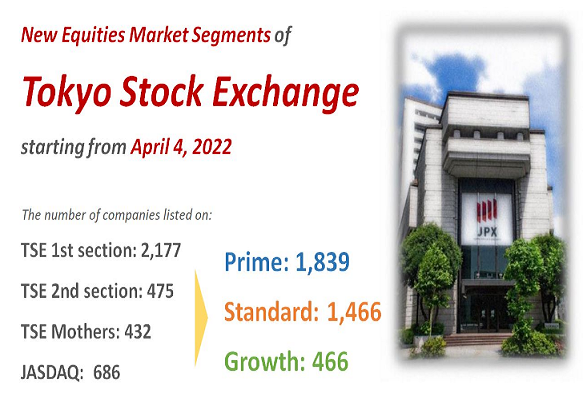TSE Cash Markets
Household financial assets at record highs, individual investment gains momentum on new NISA opportunity

The new Nippon Individual Savings Account (NISA) launched in January has accelerated individual investment. The number of new NISA accounts opened in 10 securities firms reached 2.24 million by the end of May, and the inflow of individual money continues, especially for foreign equity investment trusts.
While the influence of the current depreciation of the yen has inflated the financial outstanding amount of assets in yen terms for individuals, the shift of individuals to overseas assets has also contributed to the further depreciation of the yen. Trends in Japan’s personal financial assets, which amount to about 2,200 trillion yen, will continue to have an impact on the exchange rate that cannot be ignored.
According to the flow of funds statistics released by BOJ on 27th, households’ financial assets at the end of March increased 7.1% from the same period last year to 2,199 trillion yen. Risky assets other than deposits and savings boosted the financial outstanding amount of assets, with stocks and other securities up 33.7% YOY to 313 trillion yen and investment trusts up 31.5% to 119 trillion yen. Both reached record highs.
Holdings of stocks and investment trusts increased because domestic and overseas stock price rises boosted valuations. The Nikkei 225 hit a post-bubble high in February, and the US S&P 500 Stock Index is up about 15% since the beginning of the year. Personal financial assets at the end of March were up nearly 150 trillion yen from a year ago, with about 70% of the increase coming from stocks and investment trusts.
The launch of the new NISA has also broadened the base of investors. According to Japan Securities Dealers Association, the number of new NISA accounts opened in 10 securities firms from January to May reached a 2.6-fold increase from the same period last year. Purchases through the NISA account in the period from January to May also reached a high level of 6,614.1 billion yen, 4.2 times that of the same period last year.
Individual money is headed for foreign-currency-denominated assets. Mizuho Bank estimates that the ratio of foreign currency denominated assets reached 4.2% at the end of March, up from a record high of 3.9% at the end of December 2007. Daisuke Karakama of Mizuho Bank analyzes, “In addition to the yen’s long-standing tendency to depreciate, the yen sell-off associated with the new NISA may have increased concerns about asset formation that had been focused solely on yen-denominated assets.”
According to Nikko Research Center’s survey, net inflows into foreign equity investment trusts from January to May amounted to 5,428.4 billion yen, almost five times that of the same period last year. This inflow accounted for 77% of total net inflows into equity investment trusts, up 10 percentage points from the same period last year. The top 10 investment trusts with the highest net inflows from January to May were those investing in overseas equities, such as Mitsubishi UFJ Asset Management’s “eMAXIS Slim All Country”, a global equity investment trust.
Individuals’ shift to foreign-currency-denominated assets has contributed to the yen’s depreciation. This is because buying foreign stock investment trusts involve transactions such as selling yen to buy dollars. Although the dollar-yen exchange rate is currently at its weakest level in 37 years, if actual yen sell-off arising from individual asset management persist, it will be a factor that will not stop the yen from weakening.
Cash and deposits held by households still account for 50.9% of total financial assets at the end of March, at 1,118 trillion yen. This is well above the US (12.6% as of March 31, 2023) and the euro zone (35.5%) level.
However, the interest rates on savings accounts at major banks are still well below the rate of increase in the Consumer Price Index (CPI), and the value of cash deposits continues to diminish in real terms when inflation is factored in. With deposits alone unlikely to increase financial assets, the trend “from savings to investment” may further advance in the future.
The increase in asset holdings, mainly due to rising stock prices, will have a positive impact on consumer spending. However, this asset effect works in elderly favor, who have more financial assets, and there is concern that the gap between individuals with surplus assets that can be invested and those with assets holding as savings will widen in the future.
The Japan Research Institute estimates that if the value of stocks and other assets increases by 100 yen, the consumption of elderly households whose head of household is over 60 years old will increase by 6.0 yen. On the other hand, the figure for households under 59 years old is only 0.8 yen. The disparity is 7.5 times greater for different age groups.
The reason is that the older, the more financial assets they own. According to Ministry of Internal Affairs and Communications’ household survey, the average savings (including securities and other assets) of households with two or more members was average 19.04 million yen in 2023, but 7.82 million yen for households under 40 years old. Two-thirds of households with two or more members are below average.
Variation in the benefits of stock price rise has also occurred in the corporate sector. According to the Teikoku Databank survey, 42.8% of companies said “Benefited” from rising stock prices, with a little under 50% of said “Benefited” citing an increase in the value of their securities holdings as the reason. Companies said “No benefit” was 52.8%.
There is a possibility that consumer spending will become more polarized in the future, depending on the amount of assets held. If the weak tone of personal consumption continues, especially among households with children and the younger generation, companies will not be able to pass on prices, and the realization of BOJ’s 2% price stability target may be far off. BOJ will carefully determine the path of interest rate hikes, while also keeping an eye on consumer spending, which accounts for the majority of gross domestic product (GDP).
Related links





